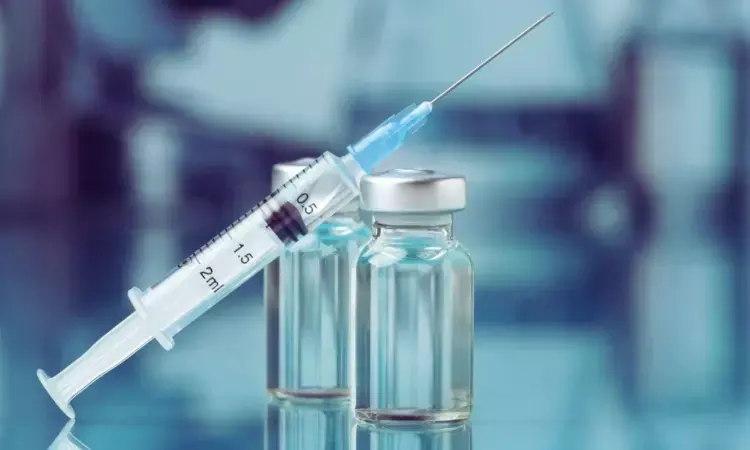- Home
- Medical news & Guidelines
- Anesthesiology
- Cardiology and CTVS
- Critical Care
- Dentistry
- Dermatology
- Diabetes and Endocrinology
- ENT
- Gastroenterology
- Medicine
- Nephrology
- Neurology
- Obstretics-Gynaecology
- Oncology
- Ophthalmology
- Orthopaedics
- Pediatrics-Neonatology
- Psychiatry
- Pulmonology
- Radiology
- Surgery
- Urology
- Laboratory Medicine
- Diet
- Nursing
- Paramedical
- Physiotherapy
- Health news
- Fact Check
- Bone Health Fact Check
- Brain Health Fact Check
- Cancer Related Fact Check
- Child Care Fact Check
- Dental and oral health fact check
- Diabetes and metabolic health fact check
- Diet and Nutrition Fact Check
- Eye and ENT Care Fact Check
- Fitness fact check
- Gut health fact check
- Heart health fact check
- Kidney health fact check
- Medical education fact check
- Men's health fact check
- Respiratory fact check
- Skin and hair care fact check
- Vaccine and Immunization fact check
- Women's health fact check
- AYUSH
- State News
- Andaman and Nicobar Islands
- Andhra Pradesh
- Arunachal Pradesh
- Assam
- Bihar
- Chandigarh
- Chattisgarh
- Dadra and Nagar Haveli
- Daman and Diu
- Delhi
- Goa
- Gujarat
- Haryana
- Himachal Pradesh
- Jammu & Kashmir
- Jharkhand
- Karnataka
- Kerala
- Ladakh
- Lakshadweep
- Madhya Pradesh
- Maharashtra
- Manipur
- Meghalaya
- Mizoram
- Nagaland
- Odisha
- Puducherry
- Punjab
- Rajasthan
- Sikkim
- Tamil Nadu
- Telangana
- Tripura
- Uttar Pradesh
- Uttrakhand
- West Bengal
- Medical Education
- Industry
Buprenorphine with proper medical counseling effective against opioid use disorder: JAMA

Punjab Authorizes MOs to Manage Opioid Clinics
A new study published in the Journal of American Medical Association revealed that for opioid use disorder, buprenorphine combined with proper, low-intensity medical counseling is very beneficial.
The effectiveness of combining behavioral therapy with medical management and buprenorphine treatment for opioid use disorder (OUD) has been examined in a number of sizable, randomized clinical studies. Overall treatment response rates have been consistently high in these investigations, with no discernible additive benefit from extra behavioral therapy.
Thus, this study was to fill in the knowledge gaps regarding additional behavioral therapy for buprenorphine-using patients. These gaps included whether certain subgroups respond better to additional behavioral therapy and whether additional behavioral therapy is associated with retention and functional outcomes.
This study is a secondary analysis of four randomized clinical trials that were carried out between 2000 and 2011 in ten different US locations, including Southern California and Connecticut. Adults with opioid dependency as defined by the Diagnostic and Statistical Manual of Mental Disorders, Fourth Edition, were among the participants.
Standard medical management, standard medical management plus opioid dependence counseling, physician management plus cognitive behavioral therapy, physician management, contingency management plus cognitive behavioral therapy, contingency management, and no additional behavioral treatment are among the behavioral therapy levels that are combined with buprenorphine.
The Addiction Severity Index was used to measure the primary outcomes, which included weeks of buprenorphine retention and functioning in seven domains (medical, employment and financial assistance, social and familial, alcohol, drug, legal, and psychiatric).
A total of 869 adults (mean [SD] age: 34.2 [10.4] years; 287 female [33%]) made up the combined sample. In contrast to medical treatment and buprenorphine (mean [SD] number of opioid-free weeks, 7.00 [4.33]), the results showed that additional behavioral therapy was not linked with opioid-free weeks (mean [SD] number of opioid-free weeks, 7.16 [4.35]) (B = 0.28; 95% CI, -0.33 to 0.89; P =.37).
When compared to medical management and buprenorphine (mean [SD] number of weeks of buprenorphine, 10.21 [3.15]), additional behavioral therapy was not linked to higher buprenorphine retention (mean [SD] number of weeks of buprenorphine, 10.29 [3.21] out of 12) (B = 0.00; 95% CI, −0.43 to 0.43; P =.98).
Functional measures showed little change throughout therapy, and the randomized groups did not vary from one another. Once repeated comparisons were taken into account, there were no discernible moderating effects of subgroups (such as history of heroin use). Overall, when paired with medical therapy for opioid use disorder, the results of these clinical trials demonstrate the effectiveness of buprenorphine treatment.
Reference:
McHugh, R. K., Bailey, A. J., McConaghy, B. A., Weiss, R. D., Fiellin, D. A., Hillhouse, M., Moore, B. A., & Fitzmaurice, G. M. (2025). Behavioral therapy as an adjunct to buprenorphine treatment for opioid use disorder: A secondary analysis of 4 randomized clinical trials. JAMA Network Open, 8(8),. https://doi.org/10.1001/jamanetworkopen.2025.28529
Neuroscience Masters graduate
Jacinthlyn Sylvia, a Neuroscience Master's graduate from Chennai has worked extensively in deciphering the neurobiology of cognition and motor control in aging. She also has spread-out exposure to Neurosurgery from her Bachelor’s. She is currently involved in active Neuro-Oncology research. She is an upcoming neuroscientist with a fiery passion for writing. Her news cover at Medical Dialogues feature recent discoveries and updates from the healthcare and biomedical research fields. She can be reached at editorial@medicaldialogues.in
Dr Kamal Kant Kohli-MBBS, DTCD- a chest specialist with more than 30 years of practice and a flair for writing clinical articles, Dr Kamal Kant Kohli joined Medical Dialogues as a Chief Editor of Medical News. Besides writing articles, as an editor, he proofreads and verifies all the medical content published on Medical Dialogues including those coming from journals, studies,medical conferences,guidelines etc. Email: drkohli@medicaldialogues.in. Contact no. 011-43720751


